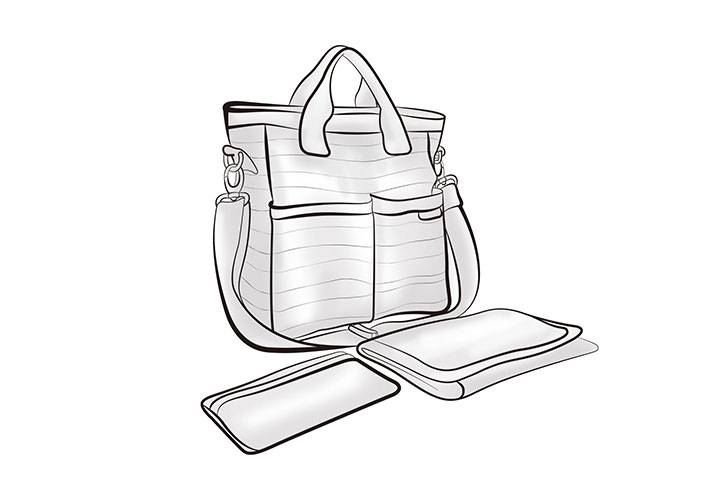Blogs & News
We have a lot of ideas and know-how about bags, material sourcing, sampling, production and a whole host of bag-related topics that we would like to share with you.
How DTC Brands Can Win the Market Through Product Design

In today’s highly competitive consumer market, Direct-to-Consumer (DTC) brands are rising at an unprecedented pace. These brands bypass traditional retailers and establish direct relationships with their consumers, infusing new energy into the market. However, in an era of information transparency and abundant choices, offering just a “good product” is no longer enough to stand out. Product design has become the key weapon for DTC brands to win the market.
This article will explore the importance of product design, the core strategies behind it, and real-world examples to illustrate how DTC brands can achieve market breakthroughs through exceptional design.

1. Why Is Product Design Crucial for DTC Brands?
1.1 First Impressions Drive Purchase Decisions
Consumers often make buying decisions within the first few seconds of seeing a product. For fashion items like handbags, design is the first step in capturing attention. A unique and refined design not only sparks consumer interest but also creates the potential for social media sharing and discussion, which significantly enhances brand visibility.
1.2 Core of Differentiated Competition
DTC brands, unlike traditional brands, may lack long-established histories and large advertising budgets. They need differentiation to establish their market position. Outstanding design helps brands develop a distinct visual language, creating a strong brand identity that consumers can instantly recognize and remember.
1.3 Meeting Individual Needs
Modern consumers are increasingly focused on expressing their individuality. They want products that reflect their taste and values. Through thoughtful product design, DTC brands can better meet this need and form an emotional connection with consumers.
1.4 Enhancing Pricing Power
High-quality design doesn’t just improve functionality and aesthetics—it also increases the perceived value of a product. A well-designed product can justify a higher price point, allowing brands to elevate their profit margins.

2. How Can DTC Brands Win the Market Through Design?
2.1 In-Depth Understanding of Target Users
Successful design starts with a deep understanding of your target audience. The advantage of DTC brands lies in their ability to interact directly with consumers, gather real feedback, and adjust strategies quickly. Some methods to gain these insights include:
- Data-Driven Design: Use social media analytics, surveys, and customer feedback to understand consumer preferences, pain points, and trends.
- Contextual Thinking: Consider the product’s use in different scenarios. For example, a daily commuter bag needs a balance of practicality and style, while an evening bag demands more luxury and elegance.
- Cultural Resonance: Incorporate the cultural and aesthetic preferences of the target market. Understanding local traditions and values helps design products that appeal to the right audience.
2.2 Creating Iconic Design Elements
Every successful brand has its signature design language, like Chanel’s iconic quilted pattern or Gucci’s GG logo. DTC brands can also build their unique style by focusing on:
- Color and Material Innovation: Experiment with bold color combinations or eco-friendly materials that make the product stand out.
- Functional Design: Add practical features like hidden pockets, adjustable straps, or convertible designs while maintaining aesthetic appeal.
- Storytelling Through Design: Every product can tell a story, whether it’s about its inspiration, materials, or craftsmanship. Story-driven designs deepen consumer engagement and loyalty.
2.3 Emphasizing Sustainability and Social Responsibility
As environmental awareness grows, more consumers are leaning toward brands with sustainable practices. DTC brands can integrate sustainability into their design through:
- Eco-friendly Materials: Use recycled leather, plant-based fibers, or biodegradable fabrics.
- Waste Reduction: Optimize production processes to minimize waste, and offer limited-edition or customized products to avoid inventory excess.
- Conveying Values: Through packaging, marketing, and storytelling, brands can communicate their commitment to environmental protection and social responsibility.
2.4 Empowering Design with Technology
Technology is revolutionizing the design process and offering new possibilities for DTC brands:
- Virtual Try-Ons & AR Experiences: Use augmented reality to allow customers to “try on” handbags virtually, reducing hesitation in purchasing and enhancing online shopping experiences.
- 3D Modeling & Rapid Sampling: Leverage digital tools to shorten design cycles and quickly respond to market needs.
- Smart Hardware Integration: Incorporate smart features like charging ports or tracking chips into handbags, adding both practicality and a futuristic appeal.
2.5 Co-Creation Through Community Engagement
One of the most significant advantages of DTC brands is their close interaction with consumers. By involving customers in the design process, brands can gather valuable insights while strengthening user loyalty. Examples include:
- Crowdsourced Design Polls: Let consumers vote on new designs or features.
- Limited Edition Collaborations: Partner with influencers or artists to create exclusive collections that generate buzz.
- UGC (User-Generated Content) Incentives: Encourage consumers to share photos or videos of themselves using the product, offering rewards for participation.

3. Case Studies of Successful DTC Brand Designs
Case 1: Away – Minimalist Design + Ultimate Functionality
Away, a direct-to-consumer brand focused on luggage, quickly dominated the market with its minimalist design and superb functionality. Their bags feature durable polycarbonate exteriors, removable compression bags, and USB charging ports, making them both aesthetically pleasing and highly functional. Additionally, Away’s strong presence on social media, showcasing real travel stories from users, further strengthened its emotional connection with customers.
Case 2: Rothy’s – Sustainable Materials + Stylish Design
Rothy’s has built its brand around sustainability, using recycled plastic bottles to create the fabric for their shoes and bags. Their colorful, stylish designs appeal to millennials who are environmentally conscious but still desire trendy products. By combining fashion and eco-consciousness, Rothy’s became a standout in the DTC space, particularly among younger consumers who value both sustainability and aesthetics.
Case 3: Cuyana – “Fewer, Better” Design Philosophy
Cuyana’s mantra, “fewer, better,” emphasizes high-quality, timeless designs over fast fashion. Their handbags feature clean lines, premium materials, and a minimalist approach that appeals to women seeking sophistication and long-lasting quality. By targeting the modern woman’s desire for simple elegance, Cuyana has carved out a successful niche in the luxury DTC market.

4. Conclusion and Outlook
Product design is not just a key factor in winning the market for DTC brands—it’s a powerful tool for shaping a brand’s identity, building consumer loyalty, and establishing a long-term competitive advantage. As consumer needs continue to evolve and technology advances, DTC brands must focus on:
- Consumer-Centric Design: Continuously designing products that address real consumer pain points and needs.
- Innovation: Embracing new materials, technologies, and ideas to keep the brand fresh and relevant.
- Staying True to Core Values: Communicating your brand’s mission and values through design to create a deeper emotional connection with consumers.
As a women’s handbag manufacturer, we understand the power of design in building successful DTC brands. If you’re looking for a trusted partner to help transform your ideas into beautiful, functional designs, we’re here to bring your vision to life. Let’s create handbags that resonate with your audience and set your brand apart in the market.

